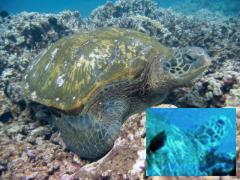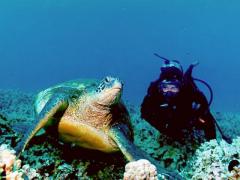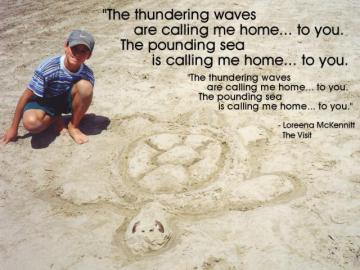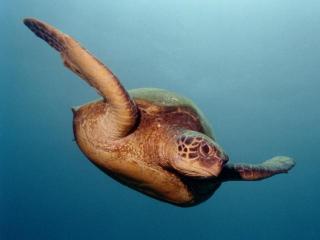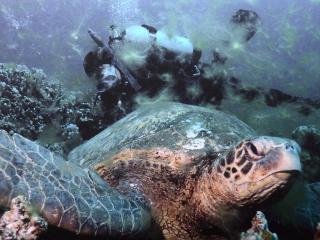Ho'oulu a/k/a Gotcha [1992 Turtle 12]
|
|
That was then (inset, 1992) and this is now (2004).
72K JPEG
|
| Quickstats: Seen 1992, 1993, 1994, 1995, 1996, 1997, 1998 (61K JPEG), 2000 (62K JPEG), 2001 (70K JPEG), 2002 (70K JPEG), 2003 (67K JPEG), 2004. |
Updates: Winter 1999, Summer 1999, Summer 2000, Summer 2001, Summer 2002, Summer 2003, Summer 2004. |
We've known Gotcha since 1992. "Gotcha" seems an odd name for a turtle, until you realize it took us most of that summer to creep up close enough to get a decent photograph of her. We need photographs of a turtle's facial pattern to confirm its identity from year to year.
After many attempts in 1992, Ursula got lucky. Carefully and slowly she sneaked up on this turtle, camera aimed and ready. She finally got close enough and just as the turtle lifted, she saw the honu's facial markings through the viewfinder and pressed the shutter. "Gotcha!"
That really is how this beautiful turtle got her name.
Those were the early days before we understood the importance of a name. We have since realized that all honu carry within them Hawaiian names and it only requires careful observation to have each turtle reveal its special name to us.
Over the years, we've seen Gotcha every summer and on almost every dive, and now she allows us to get as close as we want. She is special for many reasons--her size, her beauty--but number one is that she is the only turtle remaining from the Older Times (pre-1994) that is still tumor free.
The only one.
So when George Balazs visited with us in 1998 to help celebrate the 25th Anniversary of the French Frigate Shoals sea turtle tagging programme, Ursula wanted to photograph him beside Gotcha. She'd decided that if this splendid turtle would give George a good picture, Gotcha would receive a name change.
|
|
Ho'oulu poses with George Balazs.
44K JPEG
|
Gotcha delivered. She is now Ho'oulu.
A quick check in a Hawaiian dictionary reveals this as a perfect name for this splendid honu. "Ho'oulu" can mean "to grow, increase, spread" and she sure has spread out since 1992, but it also means "possessed/inspired by a spirit" and/or "to stir up, inspire, excite."
When she flies in and lands, she does just that to us each time--she is that beautiful--and that's ho'oulu's last meaning: "to enter in and inspire."
It's this last meaning we find the most important, especially in the 25th Anniversary year of the sea turtle tagging programme at the French Frigate Shoals (FFS). The "entering in" is that of George Balazs as he set up camp for the first time at East Island, FFS, and the terrific story there.
Ho'olulu's really large but we don't think she's mature yet. It's estimated Hawaiian green sea turtles take about 25 years to mature, so it's quite possible that George sat with her momma in those early 70's FFS days.
When George Balazs and his team visited Honokowai in January of 1999, they videotaped several of the turtles and forwarded the tape to us. It was no surprise that one of the turtles that they saw was Ho'oulu. She appeared to be bigger than ever and just as healthy. We are not certain we'll see her this summer, however, because if Ho'oulu is truly a female as we suspect, she's probably ready to start nesting migrations to the French Frigate Shoals.
Imagine seeing a turtle on almost every dive in the summers of 1992, 1993, 1994, 1995, 1996, 1997, 1998--and then you don't see her even once! That is what happened to us this summer.
We've long suspected Ho'olulu is a female, and last year her impressive girth let us know she was really packing in the "limu." At this point we are fairly confident what has happened. Like Tiamat before her, we believe Ho'olulu has migrated and laid down eggs this summer at East Island, French Frigate Shoals.
During the Summer 1999, we received word from George Balazs that both Tutu and McTaggert were at the Shoals making more honu. It was easy for us to get that information because both Tutu and McTaggert have tags!
Because Ho'olulu would be a first time nester, however, we have no way to identify her except her face. George and his FFS team use only tags and PIT tags. So we must wait until we see Ho'olulu again in Summer 2000.
Like Tutu, Mendelbrot, McTaggert, and Tiamat before her, we are certain Ho'olulu will return to her Honokowai home after she's finished nesting at the Shoals. If she completed her journey and she's alive, we'll see her at her favourite Honokowai reef in about nine months.
Female sea turtles really are that loyal to their home foraging grounds.
A charm to call them home
One of Ursula's former Grade 6 students, Brian G., made a turtle sand sculpture while on vacation at Wasaga Beach, Ontario. Brian hopes Ho'oulu and McTaggert complete their migration safely. His beautiful sand turtle will serve as a good luck charm and "call" to these honu to come home.
We're still not sure what happened. A turtle we've known since 1992 and seen almost daily since goes missing for the whole 1999 summer, and then there she is--back in Summer 2000.
We resighted Ho'oulu on our first dive of the 2000 season at her favourite resting site (where we last saw her in August 1998). Ho'oulu treated us as if no time had passed at all, allowing us close and lengthy inspection.
Inspect we did. We checked the right rear of her shell carefully for the engraved numbers we fully expected to be there. Had to be. She'd been gone a whole summer and the only explanation was that she had matured and migrated to French Frigate to nest.
But no. Try as we could, there was no trace of engraving on her shell that would explain her absence from Honokowai. Certainly it is possible that Ho'oulu just spent Summer 1999 somewhere else, but we still believe this chunky "ocean-liner" was away on her first nesting migration.
We believe this "she-was-off-nesting" hypothesis makes more sense than a "she-was-just-gone-and-now-she's-back" shoulder shrug. The turtle workers at French Frigate might have missed her nesting--or more likely, Ho'oulu nested somewhere other than East Island, where the majority of honu lay their eggs.
Either way, no matter. Ho'oulu was back and we were happy to see our old friend.
She's BIG!
Our greatest joy is watching her "fly in" after sipping air from the surface. Wings spread out and eyes on her resting spot, Ho'oulu is at her most beautiful.
Then at the last moment, to slow herself she turns full-circle, and lands. Sweet and true. Head and eyes propped over the corals the better to see with, my dear.
We're worried about her though. We took macro photographs of her eyes and her right is showing the abnormalities we've learn to associate with fibropapilloma. We fear by next summer Ho'oulu will have a true tumour in both her eyes.
For now, we've listed her as "FP suspected".
We quickly resighted Ho'oulu--first dive of the summer actually. No surprise, we found her exactly where we expected her to be. She was resting comfortably at the spot she's preferred for the last three years now.
It's a depression (made by the 150 kilo turtle, give or take a few) at the deepest ocean side of Reef 2. She defends her "nest" against all potential usurpers--and she's as resolute as she is successful in staying put.
We turned out to be wrong about Ho'oulu having tumours in her eyes for Summer 2001. Of course we're relieved and happy about her continued good health.
Ho'oulu is enormous, and is our largest turtle with possibly the exception of Zeus. Ho'oulu also provided us with wonderful memories and one of the best photographs we shot all summer.
|
|
George Balazs, Hawaii's sea turtle expert, pays his respects to Ho'oulu and relieves her of some skin barnacles!
61K JPEG
|
It's always great to resight an old friend, but the experience is made even sweeter when you meet on your first dive of a new season and the turtle's in the same place you left her ten months before! So good to see Ho'oulu again!
My, she's a big turtle!
She blessed us with her presence most days for Summer 2002. She'd spread herself out between two preferred spots along the Reef 2 complex. While she still spent most of her time at her down-current location, she'd now "built" a new rest spot along the northern perimeter of Reef 2.
Her repeated visits to this new site meant she was crushing corals and trampling them into a circular depression that not only accommodated her body shape perfectly but also allowed for a coral structure that could serve as a headrest!
This summer Ho'oulu did her bit for Science too. George Balazs strapped a Time-Depth Recorder (TDR) to her left leg in order to determine her activities over a two-week period. Things were proceeding beautifully, too.
Then, two days before we were to pull her TDR, Ho'oulu showed up at her rest spot but the TDR didn't! It had fallen off! We looked all over but to no avail. Whether the collar snapped (it had a weak link built in) or simply snagged and was pulled off her leg we don't know.
What we do know is we lost almost two weeks of data and that ultimately hurts more than losing the device.
Live and learn.
So next summer, Ho'oulu will be a test subject again, carrying another TDR. That is, unless 2003 is like 1999 and Ho'oulu is not at Honokowai. We're not sure where she was that summer, but we believe she was nesting.
We really don't expect to see her in 2003. If she's a mature female (we believe she is) she's due to make a migration run. Let's hope this time she aims for East Island. That at least ensures she'll get a mototool engraving that would confirm where she's been when we don't see her.
2003: Home--or Away? Either way, we just hope she's safe!
Ho'oulu waited until mid-July to log in her first 2003 appearance. We were delighted and a bit surprised to see her again. This splendid honu looked simply grand! Clearly she'd prospered since we'd seen her last.
Because Ho'oulu is so large, we reckon that she must be nesting somewhere. We thought it would probably be the French Frigate Shoals, where most honu go. Her appearance in mid-July suggests that either we're wrong and she's not a mature female, or that she nested early in the season at a nesting beach that wasn't monitored. We'd love to know which.
She accepted our presence calmly and we did our best to leave her resting at the same spot we'd seen her the previous ummer. Because of her bulk she's managed to "build a nest" just for herself among the corals that have been trampled and battered from her comings and goings.
Ho'olulu was a regular welcome presence, staying either at the north end of the Reef 2 complex or (her favoured place) resting front and centre at the Battery.
If Fates are kind we can expect to see Ho'oulu again for Summer 2004. Her residency at Honokowai now stretches back to 1992. That's a long time! Well. At least for us. For a long-lived creature like a sea turtle...?
Honu time perhaps marches to a different drummer.
We saw Ho'oulu for the first time on July 6th, during our second dive of the summer. She was settled contentedly into the small Turtle Trample she's created at the northen edge of Reef 2. Not that you could miss her. As Donald Trump would say, she's "Yooge!"
This is why we're pretty sure Ho'oulu is female--but we're not sure. There's no sign of her tail growing, which it would have to do if Ho'oulu is a male. We've known Ho'oulu since 1992, and we estimated that she was big enough to begin nesting way back in 1995. We have never measured Ho'oulu, but we're confident that her curved carapace length is well over 100 cm. That's larger than a lot of nesters, yet the latest we've ever sighted Ho'oulu was July 16, except for 1999 when we didn't see her at all.
So, Ho'oulu is one of our Big Puzzles. If she nests, where does she do it? She's never missing long enough to go far. If she doesn't, why not?
Ho'oulu has been dependable for so many years it would be disconcerting not to see her next summer. On the other hand, we'd really love it if she were absent until late August and then showed up with a mototool number. Could happen.
Last modified 04/09/18
Send comments or corrections to webmaster@turtles.org
